Why Hitman: Absolution Isn’t Quite Right
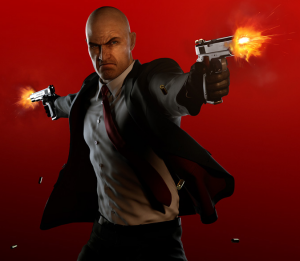 Disclaimer: this blog post assumes you have a modicum of knowledge about the Hitman series of games. If not, there’s not much point in reading further! I’ve also tried to keep this as spoiler-free as possible.
Disclaimer: this blog post assumes you have a modicum of knowledge about the Hitman series of games. If not, there’s not much point in reading further! I’ve also tried to keep this as spoiler-free as possible.
I’m well aware that it’s all too easy to use the internet to bitch about things that don’t meet one’s perceptions – I mean, that’s what it’s for, right? That, and porn.
Let’s kick this off by establishing that the latest Hitman game is far from bad – it’s very enjoyable. It’s leagues away from being terrible, and I can see why it’s getting lauded as “game of the year” by a lot of game magazines1 but I can also sympathise with those declaring it to be the biggest disappointment of the year too. Having completed it two days ago at the time of writing, I’m about to give it a retry on a harder difficulty; not just because I’m a massive trophy whore completionist, but also because I can’t quite make my mind up about it. I’ve since played the previous instalment, Blood Money (until five in the morning) and can confirm that Absolution isn’t a patch on it, but it’s not a complete derailment of the franchise by any means.
I was genuinely concerned with the prospect of a new Hitman game, as the last two titles by IO Interactive have been (in order) pretty standard2 and (apparently as I never played it) downright awful. With the mishandling of Kane and Lynch, I wasn’t sure that I wanted IO Interactive to attempt a new instalment of one of my favourite series. Hate sites listing the reasons it was going to be bad didn’t help. Now it’s done, here’s a few points (about 2000 words of them, because blog posts are supposed to be short apparently).
The marketing was completely mishandled
Probably the biggest gaffe was the now infamous video of killer nuns (see below, if you must) which caused controversy that I suspect was entirely intentional. I wasn’t too surprised by the scantily-clad nuns because the last two games have featured levels where women hardly wearing anything attempt to kill you (one wearing a halo and angel wings in one case), that’s just the kind of anti-feminine stuff that happens in Hitman. I’d call it part of the “black humour” of the series as Agent 47 is a sexless, emotionless clone built to kill, meaning that the overt sexualisation of the female assassins is just a dud tactic. If 47 got killed by these almost naked assassins, it was because the player had fell for the trick.
As for controversy, there’s the small matter of the religious temple featured in Hitman 2 – I remember a furore over the level where “you’re encouraged to shoot up a temple”, which was technically correct; you could shoot it up if you want, but if you’re playing it properly then you’d avoid doing that and try not to get caught. What kind of assassin goes out of their way to be caught by shooting up a religious building? Incidentally, I didn’t see many complaints about the fact that the mission was actually about shooting up a NATO motorcade with a sniper rifle.
Either way, the level with the nuns doesn’t play out like the trailer. They mostly just stand around yelling for 47 to reveal himself, pretty much like every other enemy in the game. I got the feeling that the controversy the trailer generated was intended, and that a lot of the voices crying out against it weren’t familiar with the Hitman series. I’m not saying that should make it acceptable, just that this is what you get with the Hitman series – it’s not particularly new to see this sort of thing within the context of the game.
There’s the small matter of the flub with a promotional app where people could get 47 to threaten their mates that was quickly pulled off the app marketplace. That might have also been a genuine tactic to generate buzz about the game – it’s cheap to make your game heard via hate, but it works.
Why did they have to particularly single out the nuns? What was wrong with going with the typical marketing, of 47 brooding in shadows? I guess it just wasn’t going to grab people’s attentions as much.
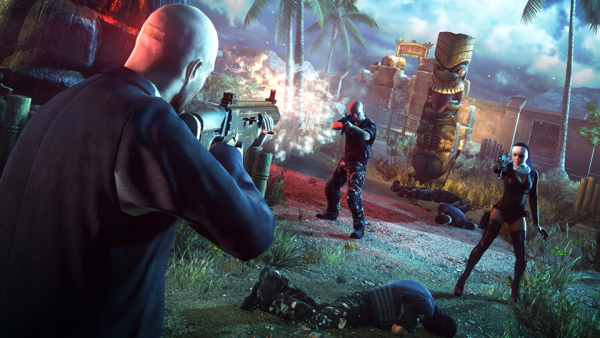
The story doesn’t feel like it should star 47
I genuinely get the feeling that IO Interactive wanted to tell a different story. Perhaps they may have even recycled a script that would have been Kane and Lynch 3.
47 is charged with saving a young girl by his old Agency contact Diana, who’s killed off in the first mission, leaving 47 as the only tie to previous games. The antagonists throughout the game mostly consist of stereotyped rednecks (or “hicks”, you could say), most of whom try to verbally spar with 47, which is like trying to mock a dead fish; it doesn’t work, and it’s not great to watch either. On top of that, 47 is frequently outwitted by these unsavoury types, usually making stupid mistakes3 that he shouldn’t make as he’s the world’s greatest assassin.
What the story really required was a character who’s more of a wise-ass (I could see Max Payne fitting in quite nicely). The point is, 47 is far too emotionless and meticulous to take part in the banter or be caught out like he is in this. David Bateman (who almost didn’t get the job, thank god they listened to the fans and brought him back) does an admirable job in the few instances where 47 has to convey something approaching an emotion, but you can hear where he’s straining to do it and still sound like 47. The protagonist outclasses the villains completely – it’s just some jumped up Texan arms dealer vs. a man who’s single-handedly taken out gangs of organised crime and (in the last game) other assassination bureaus.
47 doesn’t even wear a black suit and red tie much in this game and he puts a plaster over his barcode, as if they were trying to get away from that. Not cool!4

The scale of the game isn’t quite up to what’s preceded it
Because the main villain is based in America, the majority of the game takes place in Chicago and South Dakota. That breaks from the tradition of having missions set in completely different locations (or one location per mission in the last two games), and it’s a shame we’re limited to either very blue Chicago locations or very orange Dakota locations (maybe they were trying for what all modern films do with teal and orange). The American accents get a bit grating after a while, too. I don’t know if this was a move specifically designed to appeal to Americans more, but if it was then surely the protagonist should be American too, in order to fully allow them to associate more? 47’s indistinct European looks and voice jar against everyone and everything around him.
I’ll touch on the thing that has most other fans raging: the linear progression. Previously, you’d be dumped into a location with information about who you need to kill, and that was it. It was up to you to test the waters, sneak in and do the job (or just run in and shoot everyone, but that wasn’t as satisfying). Absolution follows a linear progression – you kill some people in an area or just sneak past them, and then move on to the next area to do the same. I didn’t mind it too much, it’s a shame not to have the “sandbox” but I suppose the new direction was part of trying to appeal to a wider audience of people not used to the “hands off” approach of not guiding the player every step of the way. I admit that back in the day (get back in your rocking chair, granddad!) I was put off at first by the lack of assistance from the game when I first played Hitman 2, but you learn to love the freedom.
There were some genuinely great areas in Absolution that harked back to the style of previous games, nice areas to explore and plot hits in5. My gripe is that the bits in-between, the boring corridors or the areas where you’re evading a force of people, are just filler that won’t be remembered as vividly.
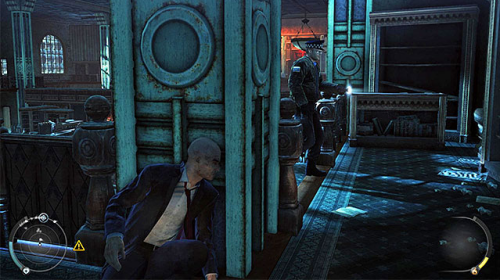
Agent 47 isn’t Batman, and shouldn’t be
The last two Batman games have been industry-changing in how they handle stealth games. Batman is all about hiding in shadows and neutralising threats quietly, and what Rocksteady did was develop something that just worked: none of the Metal Gear Solid style indicators were required, all the means of keeping tabs on enemies around you were all woven into Batman’s equipment.
IO Interactive saw how successful Batman was and thought they’d try integrating some of Rocksteady’s methods. They’ve given him Batman’s blue x-ray vision, but re-branded it as “instinct”. They’ve also nicked his radar and penchant for attacking people from behind using nothing but bare hands.
Here’s the thing: Agent 47 isn’t Batman. He doesn’t have “super sight”, and visually representing his instincts didn’t need to be in a blue x-ray haze. In previous games, if you needed to incapacitate someone you’d resort to chloroform or a poison via syringe; by giving 47 the ability to incapacitate someone with his bare hands, you’re invalidating the use of the garotte wire – his trademark weapon! I think I hardly used it throughout the game, as I could just snap a dude’s neck without it.
I missed the radar from the previous games, as it was representative of a live satellite feed from the Agency. I guess the arguments were that the map was obtrusive, and that the plot dictates that he doesn’t have Agency resources as he’s gone rogue (hence the lack of syringes of sedative/poison).
On top of these elements, they deemed it necessary to give 47 a slow-motion aim mechanic lifted from Max Payne. Unlike Max Payne, this implementation is cumbersome and fairly pointless – I hardly ever used it, apart from once or twice in fire-fights.
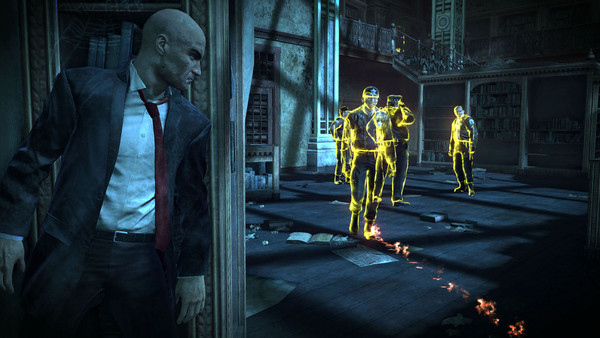
The Agency is apparently staffed by morons
The Agency that 47 works for has always been hinted to be a mysterious organisation that operates from the shadows – sure, it has had a couple of restructures in previous games, but it always gets back to business and takes a back seat to whatever 47’s up to. In this game, however, the Agency gets a starring role as 47 goes rogue and his handler is offed. In particular, it’s focused on a division of the Agency headed up by a chap with a prosthetic arm called Benjamin Travis, voiced by Powers Boothe who you might remember as that nasty Senator Rourke in Sin City (he was also Philip Marlowe on TV at one point but only I care about that).
I get the notion that 47 was presumably (hopefully!) part of a different division, as Travis’ division are a bunch of heavily armed goons who strike with all the subtlety of a rabid dog on steroids. I find it difficult to believe that 47 works for the same organisation, as whenever Travis and his goons get involved entire areas get cordoned off with trigger-happy thugs.
On top of that, Travis’ men all wear a yellow and black combination. I always assumed that 47 wore red and black in line with the Agency’s code of dress, but that’s just his personal preference according to this game. I really wish they hadn’t explored the Agency at all, as every time Travis sends men after 47 he’s issuing orders to kill him like all the other uninformed villains are. If he really had a clue, he’d probably back off completely rather than throw resources at one of the world’s greatest assassins.
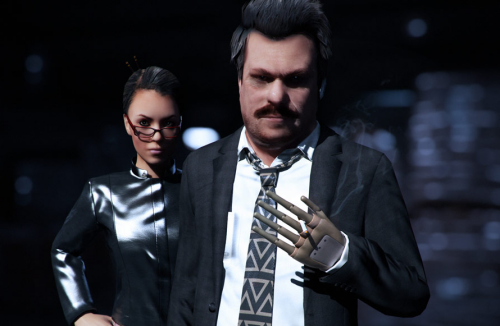
Finally, a few points that are spoilertastic
Highlight to read:
One of the big complaints made by other fans was that the Hitman doesn’t take any contracts on in this game. It’s a clever subversion at the end when you find out that 47’s handler Diana has been alive the entire time, and that 47 took on a contract from her to keep the young child alive, meaning that the events of the game are all just 47 working to complete his contract. Which is pretty cool. It’s also implied that, since funds are being transferred to his account and it’s back to business at the end, that Diana may have been acting on directives given to her by the rest of the Agency – I could be reading too much into this!
All in all…
Not a terrible game by any means, and the competitive “contracts” mode is a nice idea, if a little short on potential. I didn’t mind this one instalment deviating from the norm, but can we please have a proper Hitman game next time, IO Interactive? I’ll be buying the Hitman HD collection when it comes out in February in the meantime!
Last thing – what does that barcode on the back of 47’s head mean?
It’s – oh. Well, I didn’t expect it to be that!
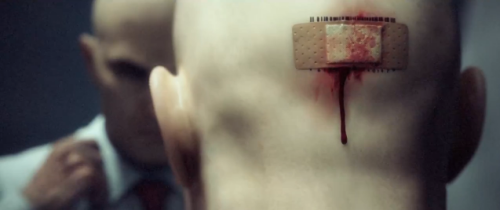
- I use “magazine” as a colloquial term that encompasses gaming websites, as digital killed the analogue star. ↩
- Allow me to link you to a rather uninformed review by myself on DeviantArt – it was one of my first PS3 games so I was dazzled by the new shininess. ↩
- To name the biggest, being heard in a ventilation grille he’s crawling through and standing in a puddle of water only to be electrocuted by a really thick Sheriff character. ↩
- Spoiler (highlight to read): the lack of suit admittedly is intentional, as you visit 47’s tailor later to get a new one (a level that was definitely necessary, I don’t think) in a moment that’s supposed to signify 47 approaching the final leg of the game. It’s a nice touch, but you don’t really feel like you’re playing 47 at his best during the rest of the game. ↩
- Just some of the better bits off the top of my head: a Chinatown marketplace, a South Dakota street, a wrestling match and a research silo. ↩
Post by Sean Patrick Payne+ | January 2, 2013 at 4:40 am | Reviews, Video Games | No comment
Tags: Agent 47, bitching about video games, Hitman, Hitman: Absolution, Square-Enix

